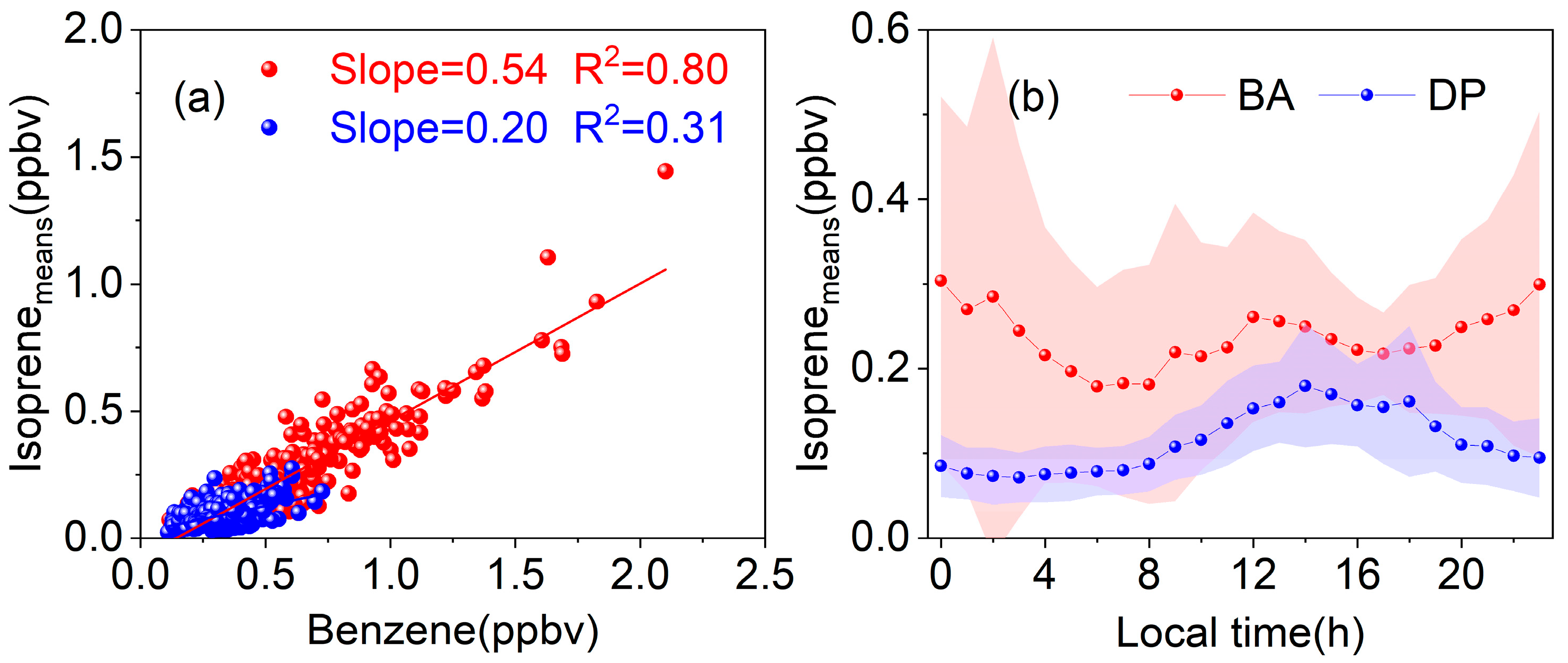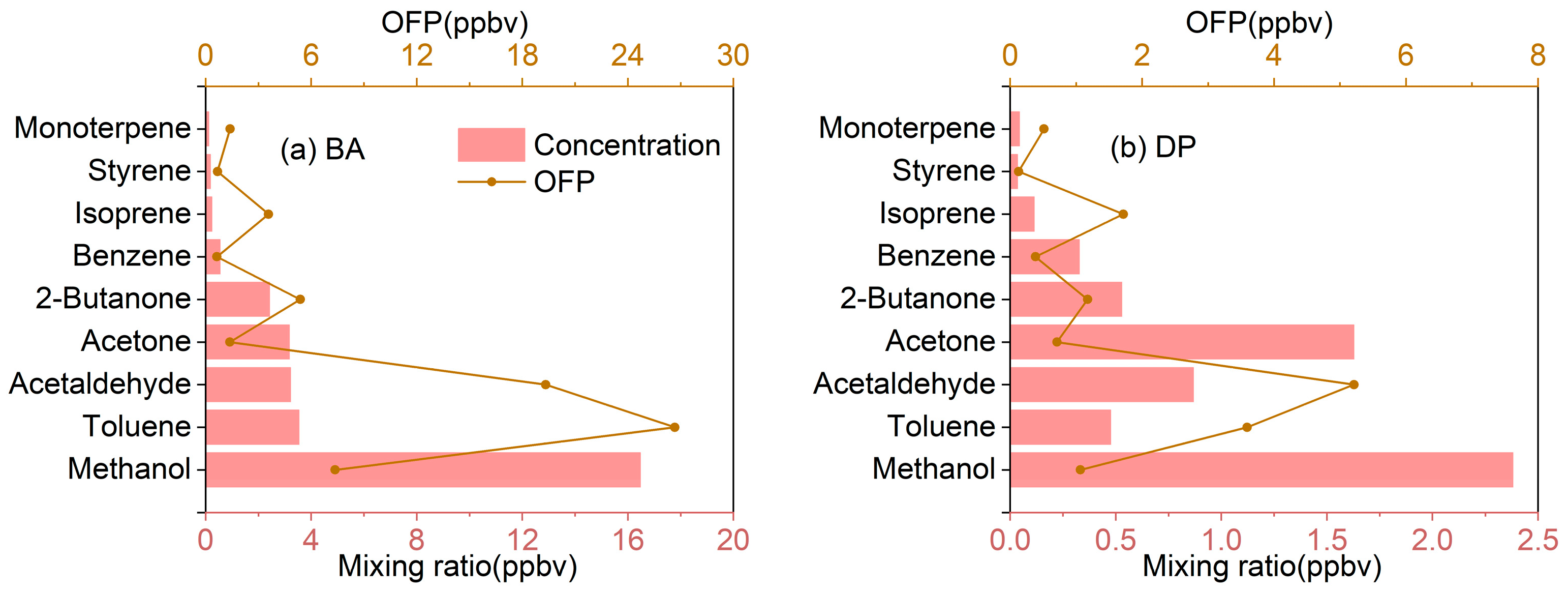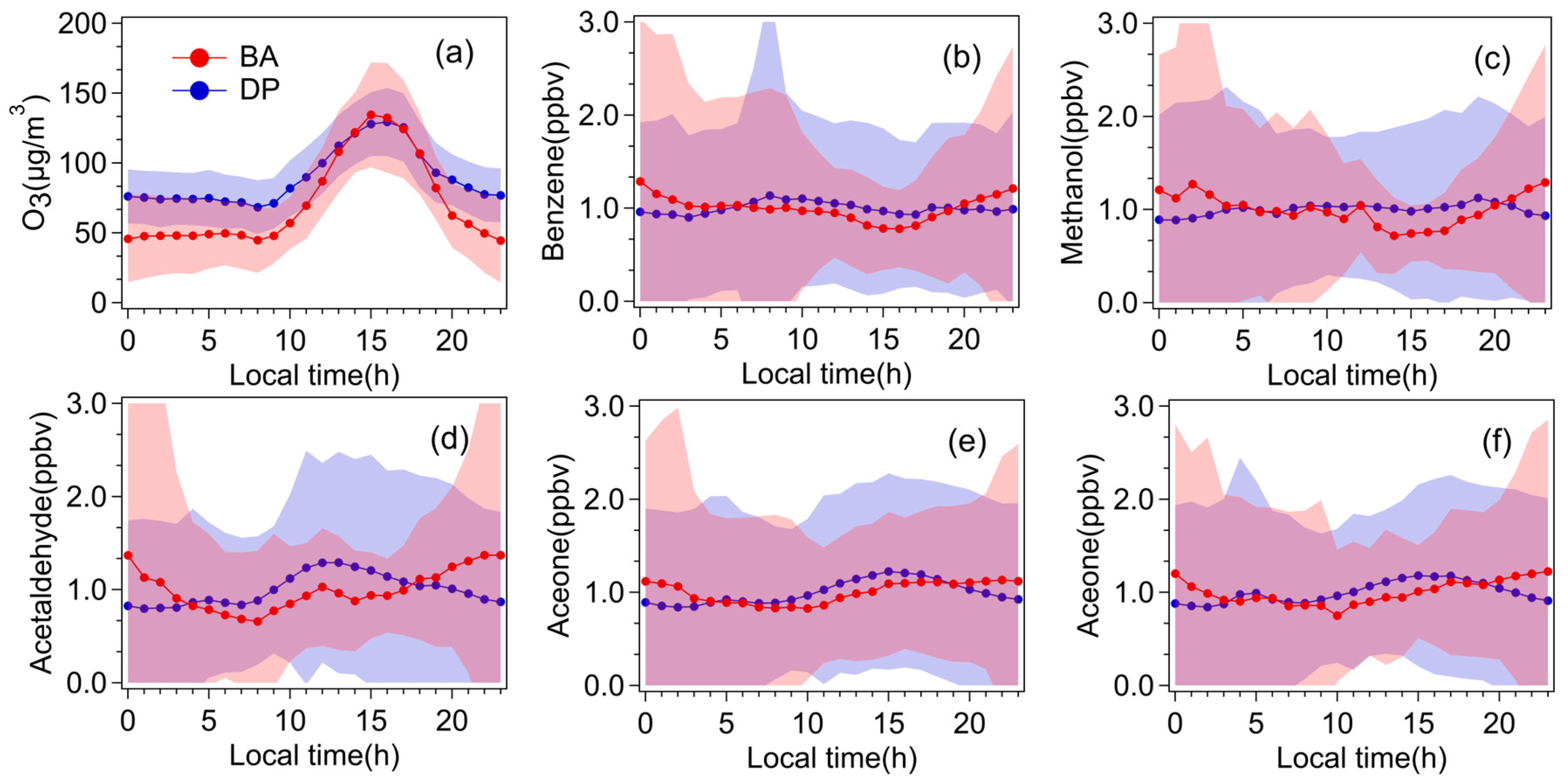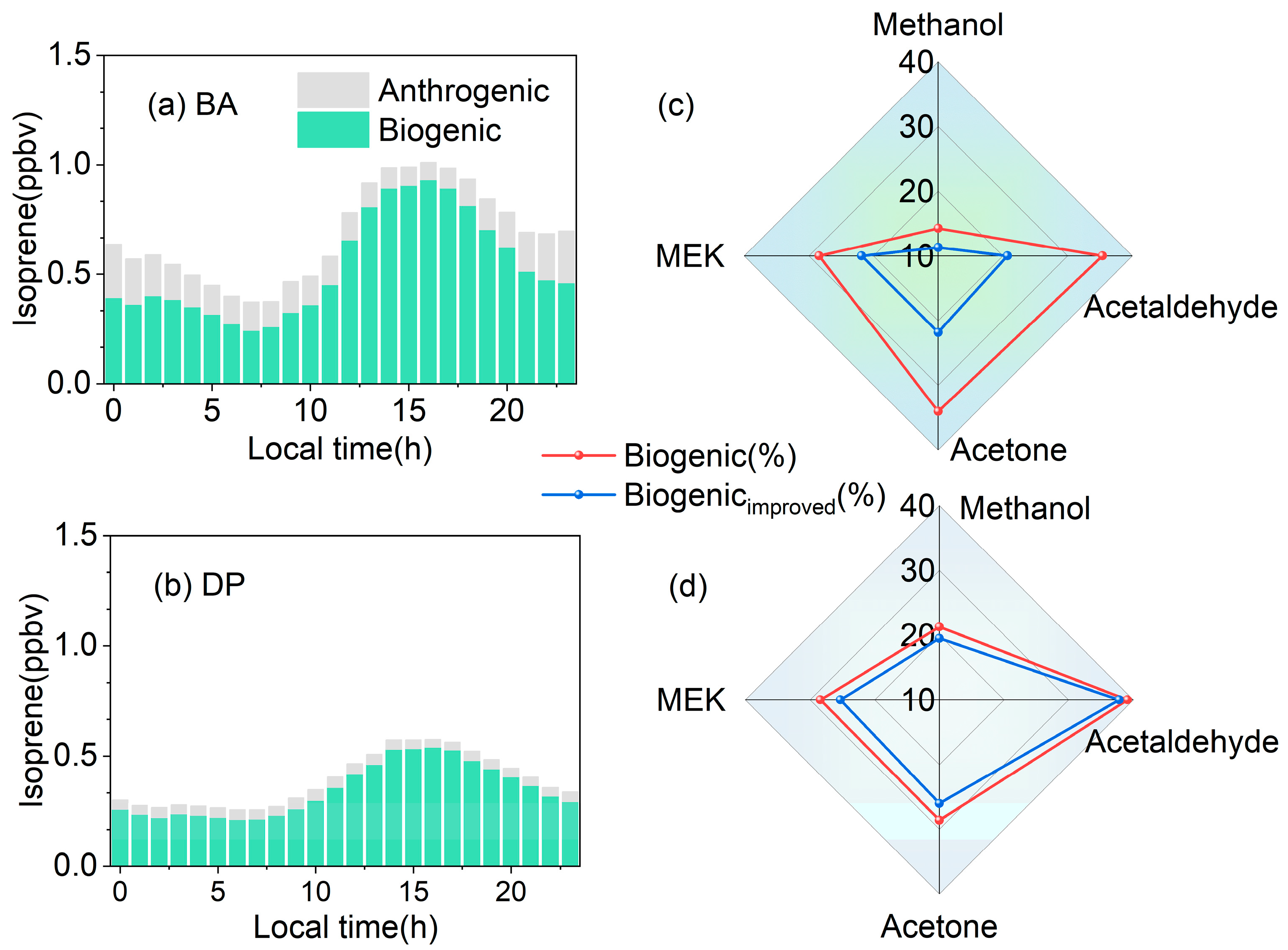Exploring the Spatial Distribution and Sources of OVOCs in Shenzhen Using an Optimized Source Apportionment Method
Abstract
1. Introduction
2. Materials and Methods
2.1. Site Descriptions and Meteorological Conditions
2.2. Online Measurement of Various VOCs
2.3. Calculation of O3 Formation Potential
2.4. Source Apportionment Method of OVOC
2.5. Optimized Biogenic Source Tracer
3. Results and Discussion
3.1. General Characteristics of Observed OVOCs
3.2. Diurnal Variation In OVOC
3.3. Anthropogenic and Biogenic Sources of Isoprene
3.4. Improved OVOC Source Apportionment
3.5. Source Apportionment of Ambient OVOCs
4. Conclusions
Supplementary Materials
Author Contributions
Funding
Institutional Review Board Statement
Informed Consent Statement
Data Availability Statement
Conflicts of Interest
References
- Wang, H.; Jing, S.; Luo, S.; Hu, Q.; Li, L.; Tao, S.; Cheng, H.; Qiao, L.; Cheng, C. Volatile organic compounds (VOCs) source profiles of on-road vehicle emissions in China. Sci. Total Environ. 2017, 607–608, 253–261. [Google Scholar] [CrossRef] [PubMed]
- Li, Y.; Liu, Y.; Hou, M.; Huang, H.; Fan, L.; Ye, D. Characteristics and sources of volatile organic compounds (VOCs) in Xinxiang, China, during the 2021 summer ozone pollution control. Sci. Total Environ. 2022, 842, 156746. [Google Scholar] [CrossRef]
- Nie, W.; Yan, C.; Huang, D.D.; Wang, Z.; Liu, Y.; Qiao, X.; Guo, Y.; Tian, L.; Zheng, P.; Xu, Z.; et al. Secondary organic aerosol formed by condensing anthropogenic vapours over China’s megacities. Nat. Geosci. 2022, 15, 255–261. [Google Scholar] [CrossRef]
- Liu, H.; Man, H.; Cui, H.; Wang, Y.; Deng, F.; Wang, Y.; Yang, X.; Xiao, Q.; Zhang, Q.; Ding, Y.; et al. An updated emission inventory of vehicular VOCs and IVOCs in China. Atmos. Chem. Phys. 2017, 17, 12709–12724. [Google Scholar] [CrossRef]
- Atkinson, R.; Arey, J. Gas-phase tropospheric chemistry of biogenic volatile organic compounds: A review. Atmos. Environ. 2003, 37, 197–219. [Google Scholar] [CrossRef]
- Zhang, W.; Xu, Y.; Bu, H.; Streets, D.G.; Wang, C. How does clean heating policy affect employment in local and neighbouring cities: Spatial quasi-experimental evidence from China. J. Clean. Prod. 2025, 503, 145399. [Google Scholar] [CrossRef]
- Zhang, W.; Xu, Y.; Jiang, L.; Streets, D.G.; Wang, C. Direct and spillover effects of new-type urbanization on CO2 emissions from central heating sector and EKC analyses: Evidence from 144 cities in China. Resour. Conserv. Recycl. 2023, 192, 106913. [Google Scholar] [CrossRef]
- Lü, H.; Cai, Q.Y.; Wen, S.; Chi, Y.; Guo, S.; Sheng, G.; Fu, J. Seasonal and diurnal variations of carbonyl compounds in the urban atmosphere of Guangzhou, China. Sci. Total Environ. 2010, 408, 3523–3529. [Google Scholar] [CrossRef]
- Tong, L.; Liao, X.; Chen, J.; Xiao, H.; Xu, L.; Zhang, F.; Niu, Z.; Yu, J. Pollution characteristics of ambient volatile organic compounds (VOCs) in the southeast coastal cities of China. Environ. Sci. Pollut. Res. 2013, 20, 2603–2615. [Google Scholar] [CrossRef] [PubMed]
- Chen, W.T.; Shao, M.; Lu, S.H.; Wang, M.; Zeng, L.M.; Yuan, B.; Liu, Y. Understanding primary and secondary sources of ambient carbonyl compounds in Beijing using the PMF model. Atmos. Chem. Phys. 2014, 14, 3047–3062. [Google Scholar] [CrossRef]
- Galbally, I.E.; Lawson, S.J.; Weeks, I.A.; Bentley, S.T.; Gillett, R.W.; Meyer, M.; Goldstein, A.H. Volatile organic compounds in marine air at Cape Grim, Australia. Environ. Chem. 2007, 4, 178–182. [Google Scholar] [CrossRef]
- Wohl, C.; Brown, I.; Kitidis, V.; Jones, A.E.; Sturges, W.T.; Nightingale, P.D.; Yang, M. Underway seawater and atmospheric measurements of volatile organic compounds in the Southern Ocean. Biogeosciences 2020, 17, 2593–2619. [Google Scholar] [CrossRef]
- Maji, S.; Beig, G.; Yadav, R. Winter VOCs and OVOCs measured with PTR-MS at an urban site of India: Role of emissions, meteorology and photochemical sources. Environ. Pollut. 2020, 258, 113651. [Google Scholar] [CrossRef]
- Zhou, X.; Li, Z.; Zhang, T.; Wang, F.; Wang, F.; Tao, Y.; Zhang, X.; Wang, F.; Huang, J. Volatile organic compounds in a typical petrochemical industrialized valley city of northwest China based on high-resolution PTR-MS measurements: Characterization, sources and chemical effects. Sci. Total Environ. 2019, 671, 883–896. [Google Scholar] [CrossRef] [PubMed]
- Sahu, L.K.; Tripathi, N.; Yadav, R. Contribution of biogenic and photochemical sources to ambient VOCs during winter to summer transition at a semi-arid urban site in India. Environ. Pollut. 2017, 229, 595–606. [Google Scholar] [CrossRef] [PubMed]
- Xia, S.-Y.; Wang, C.; Zhu, B.; Chen, X.; Feng, N.; Yu, G.-H.; Huang, X.-F. Long-term observations of oxygenated volatile organic compounds (OVOCs) in an urban atmosphere in southern China, 2014–2019. Environ. Pollut. 2021, 270, 116301. [Google Scholar] [CrossRef]
- Dai, J.; Zhang, K.; Feng, Y.; Yi, X.; Li, R.; Xue, J.; Li, Q.; Shi, L.; Liao, J.; Yi, Y.; et al. Significant influence of oxygenated volatile organic compounds on atmospheric chemistry: A case study in a typical industrial city in China. Atmos. Chem. Phys. 2025, 25, 7467–7484. [Google Scholar] [CrossRef]
- Gentner, D.R.; Worton, D.R.; Isaacman, G.; Davis, L.C.; Dallmann, T.R.; Wood, E.C.; Herndon, S.C.; Goldstein, A.H.; Harley, R.A. Chemical Composition of Gas-Phase Organic Carbon Emissions from Motor Vehicles and Implications for Ozone Production. Environ. Sci. Technol. 2013, 47, 11837–11848. [Google Scholar] [CrossRef]
- Wang, S.; Yuan, B.; Wu, C.; Wang, C.; Li, T.; He, X.; Huangfu, Y.; Qi, J.; Li, X.B.; Sha, Q.E.J.A.C.; et al. Oxygenated volatile organic compounds (VOCs) as significant but varied contributors to VOC emissions from vehicles. Atmos. Chem. Phys. Discuss. 2022, 22, 9703–9720. [Google Scholar] [CrossRef]
- Wang, S.; Zhang, J.; Zhang, Y.; Wang, L.; Sun, Z.; Wang, H. Review on Source Profiles of Volatile Organic Compounds (VOCs) in Typical Industries in China. Atmosphere 2023, 14, 878. [Google Scholar] [CrossRef]
- Ou, J.; Zheng, J.; Li, R.; Huang, X.; Zhong, Z.; Zhong, L.; Lin, H. Speciated OVOC and VOC emission inventories and their implications for reactivity-based ozone control strategy in the Pearl River Delta region, China. Sci. Total Environ. 2015, 530–531, 393–402. [Google Scholar] [CrossRef]
- Rieksta, J.; Li, T.; Davie-Martin, C.L.; Aeppli, L.C.B.; Høye, T.T.; Rinnan, R. Volatile responses of dwarf birch to mimicked insect herbivory and experimental warming at two elevations in Greenlandic tundra. Plant-Environ. Interact. 2023, 4, 23–35. [Google Scholar] [CrossRef]
- Zhao, S.; Yin, D.; Yu, Y.; Kang, S.; Qin, D.; Dong, L. PM2.5 and O3 pollution during 2015–2019 over 367 Chinese cities: Spatiotemporal variations, meteorological and topographical impacts. Environ. Pollut. 2020, 264, 114694. [Google Scholar] [CrossRef] [PubMed]
- Liu, X.; Zhang, J.; Lu, Z.; Ge, Q.; Wang, S.; Chen, D.; Chen, M.; Cui, Y. Characteristics, source apportionment, and secondary transformation of volatile organic compounds during different seasons at an urban site in southeast China. J. Environ. Sci. 2025, in press. [Google Scholar] [CrossRef]
- Xu, Z.; Zou, Q.; Jin, L.; Shen, Y.; Shen, J.; Xu, B.; Qu, F.; Zhang, F.; Xu, J.; Pei, X.; et al. Characteristics and sources of ambient Volatile Organic Compounds (VOCs) at a regional background site, YRD region, China: Significant influence of solvent evaporation during hot months. Sci. Total Environ. 2023, 857, 159674. [Google Scholar] [CrossRef] [PubMed]
- Li, C.; Liu, Y.; Cheng, B.; Zhang, Y.; Liu, X.; Qu, Y.; An, J.; Kong, L.; Zhang, Y.; Zhang, C.; et al. A comprehensive investigation on volatile organic compounds (VOCs) in 2018 in Beijing, China: Characteristics, sources and behaviours in response to O3 formation. Sci. Total Environ. 2022, 806, 150247. [Google Scholar] [CrossRef] [PubMed]
- Li, B.; Ho, S.S.H.; Gong, S.; Ni, J.; Li, H.; Han, L.; Yang, Y.; Qi, Y.; Zhao, D. Characterization of VOCs and their related atmospheric processes in a central Chinese city during severe ozone pollution periods. Atmos. Chem. Phys. 2019, 19, 617–638. [Google Scholar] [CrossRef]
- Yu, S.; Wang, S.; Xu, R.; Zhang, D.; Zhang, M.; Su, F.; Lu, X.; Li, X.; Zhang, R.; Wang, L. Measurement report: Intra-and interannual variability and source apportionment of volatile organic compounds during 2018-2020 in Zhengzhou, central China. Atmos. Chem. Phys. 2022, 22, 14859–14878. [Google Scholar] [CrossRef]
- Mozaffar, A.; Zhang, Y.L.; Lin, Y.C.; Xie, F.; Fan, M.Y.; Cao, F. Measurement report: High contributions of halocarbon and aromatic compounds to atmospheric volatile organic compounds in an industrial area. Atmos. Chem. Phys. 2021, 21, 18087–18099. [Google Scholar] [CrossRef]
- Guo, H.; Wang, T.; Simpson, I.J.; Blake, D.R.; Yu, X.M.; Kwok, Y.H.; Li, Y.S. Source contributions to ambient VOCs and CO at a rural site in eastern China. Atmos. Environ. 2004, 38, 4551–4560. [Google Scholar] [CrossRef]
- Guo, H.; Cheng, H.R.; Ling, Z.H.; Louie, P.K.K.; Ayoko, G.A. Which emission sources are responsible for the volatile organic compounds in the atmosphere of Pearl River Delta? J. Hazard. Mater. 2011, 188, 116–124. [Google Scholar] [CrossRef]
- Yuan, B.; Hu, W.W.; Shao, M.; Wang, M.; Chen, W.T.; Lu, S.H.; Zeng, L.M.; Hu, M. VOC emissions, evolutions and contributions to SOA formation at a receptor site in eastern China. Atmos. Chem. Phys. 2013, 13, 6631–6679. [Google Scholar] [CrossRef]
- Wang, H.; Welch, A.M.; Nagalingam, S.; Leong, C.; Czimczik, C.I.; Tang, J.; Seco, R.; Rinnan, R.; Vettikkat, L.; Schobesberger, S.; et al. High temperature sensitivity of Arctic isoprene emissions explained by sedges. Nat. Commun. 2024, 15, 6144. [Google Scholar] [CrossRef]
- Borbon, A.; Fontaine, H.; Veillerot, M.; Locoge, N.; Galloo, J.C.; Guillermo, R. An investigation into the traffic-related fraction of isoprene at an urban location. Atmos. Environ. 2001, 35, 3749–3760. [Google Scholar] [CrossRef]
- Wagner, P.; Kuttler, W. Biogenic and anthropogenic isoprene in the near-surface urban atmosphere—A case study in Essen, Germany. Sci. Total Environ. 2014, 475, 104–115. [Google Scholar] [CrossRef] [PubMed]
- Panopoulou, A.; Liakakou, E.; Sauvage, S.; Gros, V.; Locoge, N.; Stavroulas, I.; Bonsang, B.; Gerasopoulos, E.; Mihalopoulos, N. Yearlong measurements of monoterpenes and isoprene in a Mediterranean city (Athens): Natural vs anthropogenic origin. Atmos. Environ. 2020, 243, 117803. [Google Scholar] [CrossRef]
- Guenther, A.B.; Jiang, X.; Heald, C.L.; Sakulyanontvittaya, T.; Duhl, T.; Emmons, L.K.; Wang, X. The model of emissions of gases and aerosols from nature version 2.1 (MEGAN2.1): An extended and updated framework for modeling biogenic emissions. Geosci. Model Dev. 2012, 5, 1471–1492. [Google Scholar] [CrossRef]
- Carter, W.P.L. Development of ozone reactivity scales for volatile organic compounds. Air Waste 1994, 44, 881. [Google Scholar] [CrossRef]
- Garcia, A.R.; Volkamer, R.; Molina, L.T.; Molina, M.J.; Samuelson, J.; Mellqvist, J.; Galle, B.; Herndon, S.C.; Kolb, C.E. Separation of emitted and photochemical formaldehyde in Mexico City using a statistical analysis and a new pair of gas-phase tracers. Atmos. Chem. Phys. 2006, 6, 4545–4557. [Google Scholar] [CrossRef]
- Ma, Y.; Diao, Y.; Zhang, B.; Wang, W.; Ren, X.; Yang, D.; Wang, M.; Shi, X.; Zheng, J. Detection of formaldehyde emissions from an industrial zone in the Yangtze River Delta region of China using a proton transfer reaction ion-drift chemical ionization mass spectrometer. Atmos. Meas. Tech. 2016, 9, 6101–6116. [Google Scholar] [CrossRef]
- Chen, W.; Xu, X.; Liu, W. Combined PMF modelling and machine learning to identify sources and meteorological influencers of volatile organic compound pollution in an industrial city in eastern China. Atmos. Environ. 2024, 334, 120714. [Google Scholar] [CrossRef]
- Yuan, Q.; Zhang, Z.; Chen, Y.; Hui, L.; Wang, M.; Xia, M.; Zou, Z.; Wei, W.; Ho, K.F.; Wang, Z.; et al. Origin and transformation of volatile organic compounds at a regional background site in Hong Kong: Varied photochemical processes from different source regions. Sci. Total Environ. 2024, 908, 168316. [Google Scholar] [CrossRef] [PubMed]
- de Gouw, J.A.; Middlebrook, A.M.; Warneke, C.; Goldan, P.D.; Kuster, W.C.; Roberts, J.M.; Fehsenfeld, F.C.; Worsnop, D.R.; Canagaratna, M.R.; Pszenny, A.A.P.; et al. Budget of organic carbon in a polluted atmosphere: Results from the New England air quality study in 2002. J. Geophys. Res. Atmos. 2005, 110, D16305. [Google Scholar] [CrossRef]
- Sheng, J.; Zhao, D.; Ding, D.; Li, X.; Huang, M.; Gao, Y.; Quan, J.; Zhang, Q. Characterizing the level, photochemical reactivity, emission, and source contribution of the volatile organic compounds based on PTR-TOF-MS during winter haze period in Beijing, China. Atmos. Res. 2018, 212, 54–63. [Google Scholar] [CrossRef]
- Han, Y.; Huang, X.; Wang, C.; Zhu, B.; He, L. Characterizing oxygenated volatile organic compounds and their sources in rural atmospheres in China. J. Environ. Sci. 2019, 31, 150–157. [Google Scholar] [CrossRef]
- Ho, K.F.; Lee, S.C.; Louie, P.K.K.; Zou, S.C. Seasonal variation of carbonyl compound concentrations in urban area of Hong Kong. Atmos. Environ. 2002, 36, 1259–1265. [Google Scholar] [CrossRef]
- Huang, X.F.; Wang, C.; Zhu, B.; Lin, L.L.; He, L.Y.J.E.P. Exploration of sources of OVOCs in various atmospheres in southern China *. Environ. Pollut. 2019, 249, 831–842. [Google Scholar] [CrossRef]
- Likun, X.; Rongrong, G.; Tao, W.; Xinfeng, W.; Sandra, S.; Donald, B.; Louie, P.K.K.; Luk, C.W.Y.; Isobel, S.; Zheng, X.J.A.C.; et al. Oxidative capacity and radical chemistry in the polluted atmosphere of HongKong and Pearl River Delta region: Analysis of a severe photochemical smogepisode. Atmos. Chem. Phys. 2016, 16, 1–26. [Google Scholar]
- Volkamer, R.; Sheehy, P.; Molina, L.T.; Molina, M.J. Oxidative capacity of the Mexico City atmosphere-Part 1: A radical source perspective. Atmos. Chem. Phys. 2010, 10, 6969–6991. [Google Scholar] [CrossRef]
- Haichao, W.; Xuefei, M.; Zhaofeng, T.; Hongli, W.; Xiaorui, C.; Shiyi, C.; Yaqin, G.; Ying, L.; Yuhan, L.; Xinping, Y. Anthropogenic monoterpenes aggravating ozone pollution. Natl. Sci. Rev. 2022, 9, nwac103. [Google Scholar] [CrossRef]
- Borbon, A.; Dominutti, P.; Panopoulou, A.; Gros, V.; Sauvage, S.; Farhat, M.; Afif, C.; Elguindi, N.; Fornaro, A.; Granier, C.; et al. Ubiquity of Anthropogenic Terpenoids in Cities Worldwide: Emission Ratios, Emission Quantification and Implications for Urban Atmospheric Chemistry. J. Geophys. Res. Atmos. 2023, 128, e2022JD037566. [Google Scholar] [CrossRef]
- Hua, J.; Wang, Q.; Chen, N.; Zhu, B.; Yu, H. Quantification and source apportionment of atmospheric oxidation capacity in urban atmosphere by considering reactive chlorine species and photochemical loss of VOCs. Sci. Total Environ. 2025, 959, 178201. [Google Scholar] [CrossRef] [PubMed]
- Wu, Y.; Fan, X.; Liu, Y.; Zhang, J.; Wang, H.; Sun, L.; Fang, T.; Mao, H.; Hu, J.; Wu, L.; et al. Source apportionment of VOCs based on photochemical loss in summer at a suburban site in Beijing. Atmos. Environ. 2023, 293, 119459. [Google Scholar] [CrossRef]
- Liu, B.; Yang, Y.; Yang, T.; Dai, Q.; Zhang, Y.; Feng, Y.; Hopke, P.K. Effect of photochemical losses of ambient volatile organic compounds on their source apportionment. Environ. Int. 2023, 172, 107766. [Google Scholar] [CrossRef]
- Brito, J.; Wurm, F.; Yáñez-Serrano, A.M.; De Assunção, J.V.; Godoy, J.M.; Artaxo, P. Vehicular Emission Ratios of VOCs in a Megacity Impacted by Extensive Ethanol Use: Results of Ambient Measurements in São Paulo, Brazil. Environ. Sci. Technol. 2015, 49, 11381–11387. [Google Scholar] [CrossRef] [PubMed]
- Zhu, B.; Han, Y.; Wang, C.; Huang, X.; Xia, S.; Niu, Y.; Yin, Z.; He, L. Understanding primary and secondary sources of ambient oxygenated volatile organic compounds in Shenzhen utilizing photochemical age-based parameterization method. J. Environ. Sci. 2019, 75, 105–114. [Google Scholar] [CrossRef]
- Wang, C.; Huang, X.F.; Han, Y.; Zhu, B.; He, L.-Y. Sources and Potential Photochemical Roles of Formaldehyde in an Urban Atmosphere in South China. J. Geophys. Res. Atmos. 2017, 122, 11–934. [Google Scholar] [CrossRef]
- Wei, C.-B.; Yu, G.-H.; Cao, L.-M.; Han, H.-X.; Xia, S.-Y.; Huang, X.-F. Tempo-spacial variation and source apportionment of atmospheric formaldehyde in the Pearl River Delta, China. Atmos. Environ. 2023, 312, 120016. [Google Scholar] [CrossRef]
- Yuan, B.; Chen, W.; Shao, M.; Wang, M.; Lu, S.; Wang, B.; Liu, Y.; Chang, C.C.; Wang, B. Measurements of ambient hydrocarbons and carbonyls in the Pearl River Delta (PRD), China. Atmos. Res. 2012, 116, 93–104. [Google Scholar] [CrossRef]
- Zhang, G.; Zhou, X.; Sun, Y.; Han, C.; Xian, J.; Mu, C.; Xu, W.; Liang, L. Oxygenated volatile organic compounds in Beijing: Characteristics, chemical reactivity, and source identification. Environ. Pollut. 2025, 373, 126065. [Google Scholar] [CrossRef]
- Hunter, J.F.; Day, D.A.; Palm, B.B.; Yatavelli, R.L.N.; Chan, A.W.H.; Kaser, L.; Cappellin, L.; Hayes, P.L.; Cross, E.S.; Carrasquillo, A.J.; et al. Comprehensive characterization of atmospheric organic carbon at a forested site. Nat. Geosci. 2017, 10, 748–753. [Google Scholar] [CrossRef]
- Legreid, G.; Lööv, J.B.; Staehelin, J.; Hueglin, C.; Hill, M.; Buchmann, B.; Prevot, A.S.H.; Reimann, S. Oxygenated volatile organic compounds (OVOCs) at an urban background site in Zürich (Europe): Seasonal variation and source allocation. Atmos. Environ. 2007, 41, 8409–8423. [Google Scholar] [CrossRef]
- Xu, Y.; Cugurullo, F.; Zhang, H.; Gaio, A.; Zhang, W. The Emergence of Artificial Intelligence in Anticipatory Urban Governance: Multi-Scalar Evidence of China’s Transition to City Brains. J. Urban Technol. 2024, 32, 9–33. [Google Scholar] [CrossRef]





Disclaimer/Publisher’s Note: The statements, opinions and data contained in all publications are solely those of the individual author(s) and contributor(s) and not of MDPI and/or the editor(s). MDPI and/or the editor(s) disclaim responsibility for any injury to people or property resulting from any ideas, methods, instructions or products referred to in the content. |
© 2025 by the authors. Licensee MDPI, Basel, Switzerland. This article is an open access article distributed under the terms and conditions of the Creative Commons Attribution (CC BY) license (https://creativecommons.org/licenses/by/4.0/).
Share and Cite
He, L.; Wei, C.-B.; Yu, G.-H.; Cao, L.-M.; Huang, X.-F. Exploring the Spatial Distribution and Sources of OVOCs in Shenzhen Using an Optimized Source Apportionment Method. Atmosphere 2025, 16, 1016. https://doi.org/10.3390/atmos16091016
He L, Wei C-B, Yu G-H, Cao L-M, Huang X-F. Exploring the Spatial Distribution and Sources of OVOCs in Shenzhen Using an Optimized Source Apportionment Method. Atmosphere. 2025; 16(9):1016. https://doi.org/10.3390/atmos16091016
Chicago/Turabian StyleHe, Li, Cheng-Bo Wei, Guang-He Yu, Li-Ming Cao, and Xiao-Feng Huang. 2025. "Exploring the Spatial Distribution and Sources of OVOCs in Shenzhen Using an Optimized Source Apportionment Method" Atmosphere 16, no. 9: 1016. https://doi.org/10.3390/atmos16091016
APA StyleHe, L., Wei, C.-B., Yu, G.-H., Cao, L.-M., & Huang, X.-F. (2025). Exploring the Spatial Distribution and Sources of OVOCs in Shenzhen Using an Optimized Source Apportionment Method. Atmosphere, 16(9), 1016. https://doi.org/10.3390/atmos16091016






